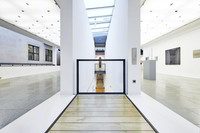A necklace, so-called "ulimi" (Zulu term for tongue) which consists out of green, white, black, red, blue and pink glass pearls and which has a broad pearl band with zigzag pattern as pendant. In between the chain and the pendant are conical brass buttons on both sides. On one side, one button is applied and on the other side, there are two buttons. Here the brass cone serves as well as fastener by pulling it through a beaded loop.
According to the inventory, it was a girl's necklace.
In 1923, Max Hößle committed the object, as part of a collection, to the Gewerbemuseum (Museum of Applied Arts) Ulm. Ulrich Hößle compiled the collection around 1880 in South Africa in the region of Pietermaritzburg in the present province of KwaZulu-Natal. The territory then belonged to the British Colony of Natal.
en

